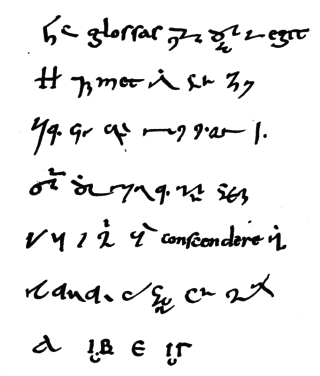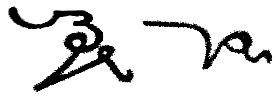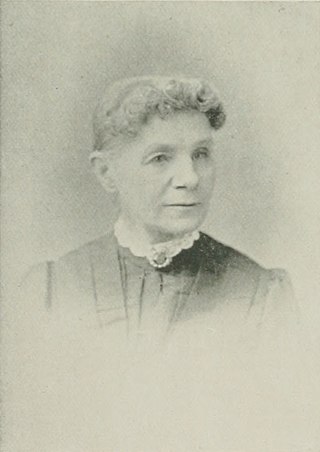This is a list of shorthands, both modern and ancient. Currently, only one shorthand (Duployan) has been given an ISO code, in preparation for inclusion in the Unicode Standard, although the Tironian et has already been included in Unicode.
| Script name | ISO 15924 | Year created | Creator | Primary languages | Notes |
|---|---|---|---|---|---|
| Abbreviated Longhand [1] | 1908 | Angus Weaver | English | Short forms based around longhand writing. | |
| Abbreviatrix | 1945 | William Paul Mishkin | |||
| Aimé Paris Shorthand [2] | 1820 | Aimé Paris | French | ||
| Alpha Hand [3] | |||||
| AgiliWriting [4] | |||||
| Bezenšek Shorthand [5] | 1923 | Anton Bezenšek | Bulgarian | ||
| Boyd's Syllabic Shorthand [6] | 1903 | Robert Boyd | English | ||
| Brachygraphie (Folkingham) [7] | 1622 | William Folkingham | English | ||
| Brachygraphy (Bales) [8] | 1590 | Peter Bales | English | ||
| Brachygraphy (Dix) [9] | 1641 | Henry Dix | English | ||
| Brachygraphy (Shelton) [10] | 1672 | Samuel Shelton | English | Based on Thomas Shelton's Tachygraphy from whom he first learned shorthand. | |
| Burmese Shorthand | 1952 | Zwe Ohn Chein | Burmese | ||
| Burnz' Fonic Shorthand | 1896 | Eliza Boardman Burnz | English | ||
| Carissimi Shorthand [11] | 1940 | Juan Antonio Carissimi | Spanish | ||
| Caton Scientific Shorthand [12] [13] | Thomas Jasper Caton | ||||
| Century 21 Shorthand [14] | |||||
| Characterie [15] | 1588 | Timothy Bright | English | ||
| Conen de Prépean Shorthand [16] | 1813 | Louis Félix Conen de Prépean | French | ||
| Coulon de Thévenot Shorthand [17] | 1776 | Jean Coulon de Thévenot | French | ||
| Current Shorthand [18] | 1892 | Henry Sweet | English | ||
| Cursive Shorthand [19] | 1889 | Hugh Longbourne Callendar | English | ||
| Dacomb Shorthand [20] | 1934 | Beatrice Eliza Dacomb | English | ||
| Dement's Aristography [21] | 1896 | Isaac Strange Dement | |||
| Deutsche Einheitskurzschrift [22] | 1924 | German | Used in Germany. | ||
| Duployé Shorthand [23] | Dupl 755 | 1868 | Émile Duployé | French, Romanian, English, Chinook Jargon | |
| Dutton Speedwords [24] | 1922 | Reginald J. G. Dutton | English, French, German, Latin | Intended as an International auxiliary language | |
| EasyScript Speed Writing [25] | |||||
| Eclectic Shorthand [26] | 1878 | J.G. Cross | English | ||
| Edmond Willis's Shorthand [27] | 1627 | Edmond Willis | English | ||
| Faulmann Shorthand [28] | 1875 | Carl Faulmann | German | ||
| Forkner shorthand [29] | 1952 | Hamden L. Forkner | English | ||
| Gabelsberger shorthand [30] | 1817 (approx.) | Franz Xaver Gabelsberger | German | ||
| Graham shorthand [31] | |||||
| Gregg Shorthand [32] | 1888 | John Robert Gregg | English, Esperanto, French, German, Italian, Mandarin Chinese, Polish, Portuguese, Spanish | ||
| Gregg Computer Shorthand / Productivity Plus [33] | |||||
| Groote [34] | 1899 | Arnold Willem Groote | Dutch | Used in the Netherlands | |
| Herout-Mikulík [35] | Alois Herout and Svojmír Mikulík | Czech | Used in the Czech parliament. | ||
| Hy-Speed Longhand [36] | 1932 | Andrew Graham Sexton and R. B. Sexton | English | ||
| Larralde Shorthand [37] | Gabriel Hilario Larralde | Spanish | Used in the Argentine congress. | ||
| Legible Shorthand [38] | 1882 | Edward Pocknell | English | ||
| Leite Alves Shorthand [39] | 1929 | Oscar Leite Alves | Portuguese | ||
| Lightning Legible Shorthand [40] | 1906 | David Rose Glass | English | ||
| Malone Shorthand [41] | |||||
| Maron Shorthand [39] | 1932 | Afonso Maron | Portuguese | ||
| Melin Shorthand [42] | 1880 | Olof Werling Melin | Swedish | Dominant Shorthand system in Sweden. | |
| Merrill Shorthand [43] [44] | 1942 | Albert Merrill | English | Also called ABC shorthand. | |
| Michela Shorthand [45] | 1862 | Antonio Michela Zucco | Italian | Used in the Italian Senate and the Regional Council of Piedmont. | |
| Moat's Short-hand Standard [46] | 1833 | Thomas Moat | English | ||
| Munson Shorthand [47] | 1867 | James Eugene Munson | English | ||
| National Simplex Shorthand [48] | 1919 | Rev. Percival Hubert Chase | |||
| Natural Shorthand [49] | 1917 | August Mengelkamp | English | ||
| New Art of Real Shorthand [50] | 1919 | John Malham-Dembleby | |||
| New Rapid [51] | 1890 | C.E. McKee | |||
| Notescript [52] | 1964 | Laurence F. Hawkins | English | ||
| Paragon Shorthand [53] | 1895 | A. Lichtentag | |||
| Personal Shorthand [54] | Carl W. Salser, C. Theo Yerian and Mark R. Salser | English | Originally called "Briefhand." | ||
| Pitman Shorthand [55] | 1837 | Isaac Pitman | English | ||
| Polygraphy [56] | 1747 | Aulay Macaulay | English | ||
| Prévost-Delaunay Shorthand [57] | 1878 | Hippolyte Prévost and Albert Delaunay | French | ||
| Reformed Phonetic Short-Hand [58] | 1868 | Andrew J. Marsh | English | ||
| Scheithauer Shorthand | 1896 | Karl Friedrich Scheithauer | German | Used in Germany. | |
| Scheithauer/Steinmetz Shorthand [59] | 2020 | Markus Steinmetz | German | Used in Germany. | |
| Short-Writing [60] | 1690 | Theophilus Metcalfe | English | ||
| Simson Shorthand [61] | 1881 | James Simson | English | ||
| Speedwriting [62] | 1924 | Emma Dearborn | English | ||
| State Unified Stenography System (GESS) [63] | 1937 | Nikolai Nikolaevich Sokolov | Russian | Used in the Soviet Union; also adapted for English, French, and some of the languages of the Soviet Union. | |
| Stenographie [64] | 1618 | John Willis | English | ||
| Stenography Compleated [65] | 1727 | James Weston | English | ||
| Stenoscript | 1950 | Manuel C. Avancena | English | ||
| Stiefografie [66] | 1966 | Helmut Stief | German | Used in Germany. | |
| SuperWrite [67] | |||||
| Tachygraphy [68] | 1626 | Thomas Shelton | English, French, German | Originally called "Short-Writing." | |
| Taylor shorthand [69] | 1786 | Samuel Taylor | English | Also known as Universal Stenography | |
| Teeline Shorthand [70] | 1968 | James Hill | English | ||
| Thomas Natural Shorthand [71] | 1935 | Charles A. Thomas | English | ||
| Tironian notes [72] | 63 BC | Marcus Tullius Tiro | Latin | ||
| Typed Shorthand [73] | 1917 | William Baines | English | Also known as Baines' Typed Shorthand. | |
| Universal English Shorthand [74] | about 1740 | John Byrom | English | ||
| Wang-Krogdahl's system [75] | 1936 | Leif Wang and Olav Krogdahl | Norwegian | Used in the Norwegian parliament. | |
| Weston's Short-hand [76] | 1727 | James Weston | English | ||
| Zeiglographia | 1650 | Thomas Shelton | English | ||
| Phillips Code [77] | 1879 | Walter P. Phillips | English | Intended for English transmitted over Telegraph in Morse code. | |
| Evans Basic English Code [78] | 1947 | John Evans | English | Based on the earlier Phillips Code but for more general use. |






